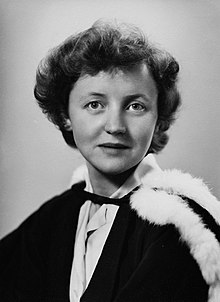|
Brenda Swinbank
Brenda Swinbank (later Heywood; 2 February 1929 – 20 December 2022) was an English archaeologist. She was one of the first women in Britain to become a professional archaeologist,[1][2] specialising in the study of Hadrian's Wall, and was instrumental in bringing to publication excavations under York Minster.[1][2] Education and careerSwinbank went to Hemsworth Grammar School in Wakefield before attending Durham University in 1946 to study Modern History, where she was inspired by Eric Birley, who invited Swinbank to stay at his house at Chesterholm, near Vindolanda, and who later described her as a "really competent excavator and field archaeologist", to excavate at Corbridge and Housesteads.[1][3] During her studies at Durham she was president of the Durham College's History Society and was a member of St Aidan's Society.[3][4] She graduated in 1949 with an upper second-class degree in History, and attended the Hadrian's Wall Pilgrimage before being awarded a two-year Durham Colleges Research Studentship.[3] In 1950, Swinbank supervised excavations at Birdoswald with John Gillam, before completing her thesis The Vallum Reconsidered, for which she received a doctorate from Durham University in 1954.[5][6] She became the third British woman awarded a PhD for a thesis on the archaeology of Britain.[1] Swinbank also excavated sections of the Vallum including at Cawfields and Great Chesters as part of her research, as well as Bewcastle, the Carrawburgh Mithraeum with Ian Richmond, and elsewhere the Roman fort of Castell Collen at Llandrindod Wells with Leslie Alcock, and the Roman fort at Penydarren in South Wales.[3] In 1956, Swinbank began a two-year assistant lectureship at the University College of South Wales and Monmouthshire, covering the history of Europe from the Classical Period to the Dark Ages.[3] In 1958, she featured alongside Eric Birley, John Gillam and Kate Hodgson in a BBC Home Service broadcast marking 1,800 years' study of Hadrian's Wall.[7] Swinbank was also elected a fellow of the Society of Antiquaries of London in 1958.[3] However, despite her achievements she was not granted a permanent university position, and in the autumn of that year took up an appointment as Assistant History Mistress at Ackworth School,[1] one of a few Quaker educational establishments in England. It was not until the late 1960s that Swinbank was able to again involve herself more fully in archaeology. She connected with Peter Wenham, an archaeologist and contact of Eric Birley. In 1968 she began to lecture the Roman Britain course at St John's College in York and assist with excavations,[8] including preparing the final report of the excavations of the vicus at Malton in 1971.[9][10] In 1974, she joined in the post-excavation processing of the great mass of archaeological materials unearthed during the stabilisation of York Minster, becoming a full-time research fellow in 1976.[8] In the words of her biographer, these consisted of "rooms full of documents, soil samples, pieces of pottery and bone, 3,000 photographs, chunks of carved stonework and even one large block of dirt weighing several tonnes." She brought these to publication as the first volume of the York Minster materials and also, in 1992, became a director of the Yorkshire Architectural & York Archaeological Society.[1][11][12] After this Swinbank returned to her former interests on the vallum of Hadrian's Wall, which, with the assistance of David Breeze, she published in the late 2000s.[1] Personal life and deathBrenda Swinbank was born on 2 February 1929, in Ackworth, West Yorkshire, the youngest of five siblings.[3] She married Peter Heywood, a teacher and colleague at the Friends' School in Ackworth, with whom she had two sons and a daughter who died.[1] Following Peter's death from prostate cancer in 2010, Swinbank moved to London to be closer to her sons,[3] one of whom, Jeremy Heywood, was the Cabinet Secretary and Head of the Civil Service.[13] By 2017, Swinbank was living with dementia; Swinbank's daughter-in-law, Suzanne Heywood, wrote a biography of her life based on Swinbank's own writings along with recollections from Swinbank's friends and colleagues.[3] Swinbank died from complications of Alzheimer's disease on 20 December 2022, at the age of 93.[14] She was survived by her son, Simon, and her six grandchildren.[15] LegacySwinbank's notes from her survey of the vallum have been used by researchers at Newcastle University as part of WallCAP to undertake further research at Heddon-on-the-Wall.[16] TrowelBlazers, an organisation dedicated to increasing the representation of women in archaeology, including through publishing biographies on their website, have included Swinbank as a notable figure for her contributions to the study of Hadrian's Wall and York Minster. It is noted, however, that Swinbank was hindered by her inability to focus more on archaeology, and her work has ultimately not received much recognition beyond those specialising in Hadrian's Wall.[17] Publications
References
|
||||||||||||
